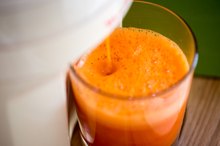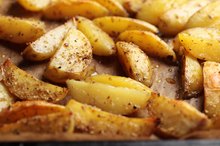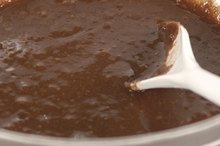What does fact checked mean?
At Healthfully, we strive to deliver objective content that is accurate and up-to-date. Our team periodically reviews articles in order to ensure content quality. The sources cited below consist of evidence from peer-reviewed journals, prominent medical organizations, academic associations, and government data.
- U.S. Department of Health & Human Services: Produce Safety
- Centers for Disease Control and Prevention: Diseases from Farm Animals
The information contained on this site is for informational purposes only, and should not be used as a substitute for the advice of a professional health care provider. Please check with the appropriate physician regarding health questions and concerns. Although we strive to deliver accurate and up-to-date information, no guarantee to that effect is made.
Bacteria From Eating Raw Vegetables
Eating 2 to 3 cups of vegetables a day can help you with weight management, give you vital nutrients and ensure you meet your dietary requirements of vegetables. However, eating raw vegetables can expose you to unwanted contaminants and bacteria. Although much of the bacteria on raw vegetables and fruits will not cause permanent harm, there are certain types that can cause severe illness.
Process
Bacteria can contaminate raw vegetables in several ways, according to the U.S. Food and Drug Administration. Vegetables grown in areas where either the soil or water comes into contact with harmful bacteria may become contaminated. Other ways of contamination include improper handling during the harvesting or storage process. Raw vegetables that encounter bacteria in a restaurant or home kitchen can also make you sick. Examples include cutting or placing raw vegetables on an unsanitized cutting board, preparing raw vegetables with unwashed hands or using the same knife to cut raw meat and vegetables.
- Bacteria can contaminate raw vegetables in several ways, according to the U.S. Food and Drug Administration.
- Examples include cutting or placing raw vegetables on an unsanitized cutting board, preparing raw vegetables with unwashed hands or using the same knife to cut raw meat and vegetables.
Types
Why Does Juicing Vegetables Cause Indigestion?
Learn More
E. coli bacteria, scientifically called Escherichia coli, lives in the intestinal tracts of both humans and animals. The deadliest strain, E. coli O157:H4 often comes from the feces of cows, sheep and goats, according to the FDA. Spinach, tomatoes, bean sprouts, cantaloupe and lettuce are some of the produce implicated in both E. coli and salmonella outbreaks in the United States. MayoClinic.com indicates that other common bacteria on raw vegetables that can make you ill include Shigella, Giardia lamblia, Listeria, Rotavirus and Noroviruses.
- E. coli bacteria, scientifically called Escherichia coli, lives in the intestinal tracts of both humans and animals.
- MayoClinic.com indicates that other common bacteria on raw vegetables that can make you ill include Shigella, Giardia lamblia, Listeria, Rotavirus and Noroviruses.
Symptoms
If you consume raw vegetables contaminated with bacteria, your symptoms will vary depending on the type of bacteria. Listeria monocytogenes may take several weeks for symptoms to appear, while eating food contaminated with salmonella may make you sick within hours. Nausea, vomiting, diarrhea, flu-like symptoms and bloody diarrhea may occur with ingesting bacteria-laden vegetables. While most healthy people recover from food poisoning, E. coli and listeria may cause serious problems in some individuals, according to the FDA's “Bad Bug Book.”
- If you consume raw vegetables contaminated with bacteria, your symptoms will vary depending on the type of bacteria.
- Listeria monocytogenes may take several weeks for symptoms to appear, while eating food contaminated with salmonella may make you sick within hours.
Strategies
What Are the Dangers of Eating Raw Vegetables?
Learn More
Wash your hands before handling raw vegetables, and wash the vegetables under quickly running water before consuming. Use separate counters and cutting boards for meats, fish, vegetables and produce to avoid cross contamination 1. Examine produce before purchasing and choose produce that appears clean, and free of punctures or scrapes 1. The FDA recommends thoroughly scrubbing vegetables with firm skin, such as cucumbers, zucchini and butternut squash before peeling or consuming. Use a clean paper towel to dry freshly washed produce before cutting 1. If possible, purchase raw vegetables from a local organic farmer.
Related Articles
References
- U.S. Department of Health & Human Services: Produce Safety
- North Carolina Department of Agriculture & Consumer Services: Bad Bug Book
- Dugum M, Barco K, Garg S. Managing irritable bowel syndrome: The low-FODMAP diet. Cleve Clin J Med. 2016;83(9):655-62. doi:10.3949/ccjm.83a.14159
- Canadian Society of Intestinal Research. IBS Diet: The Foods You Can Eat.
Writer Bio
Diane Lynn began writing in 1998 as a guest columnist for the "Tallahassee Democrat." After losing 158 pounds, she wrote her own weight-loss curriculum and now teaches classes on diet and fitness. Lynn also writes for The Oz Blog and her own blog, Fit to the Finish. She has a Bachelor of Science in finance from Florida State University.









